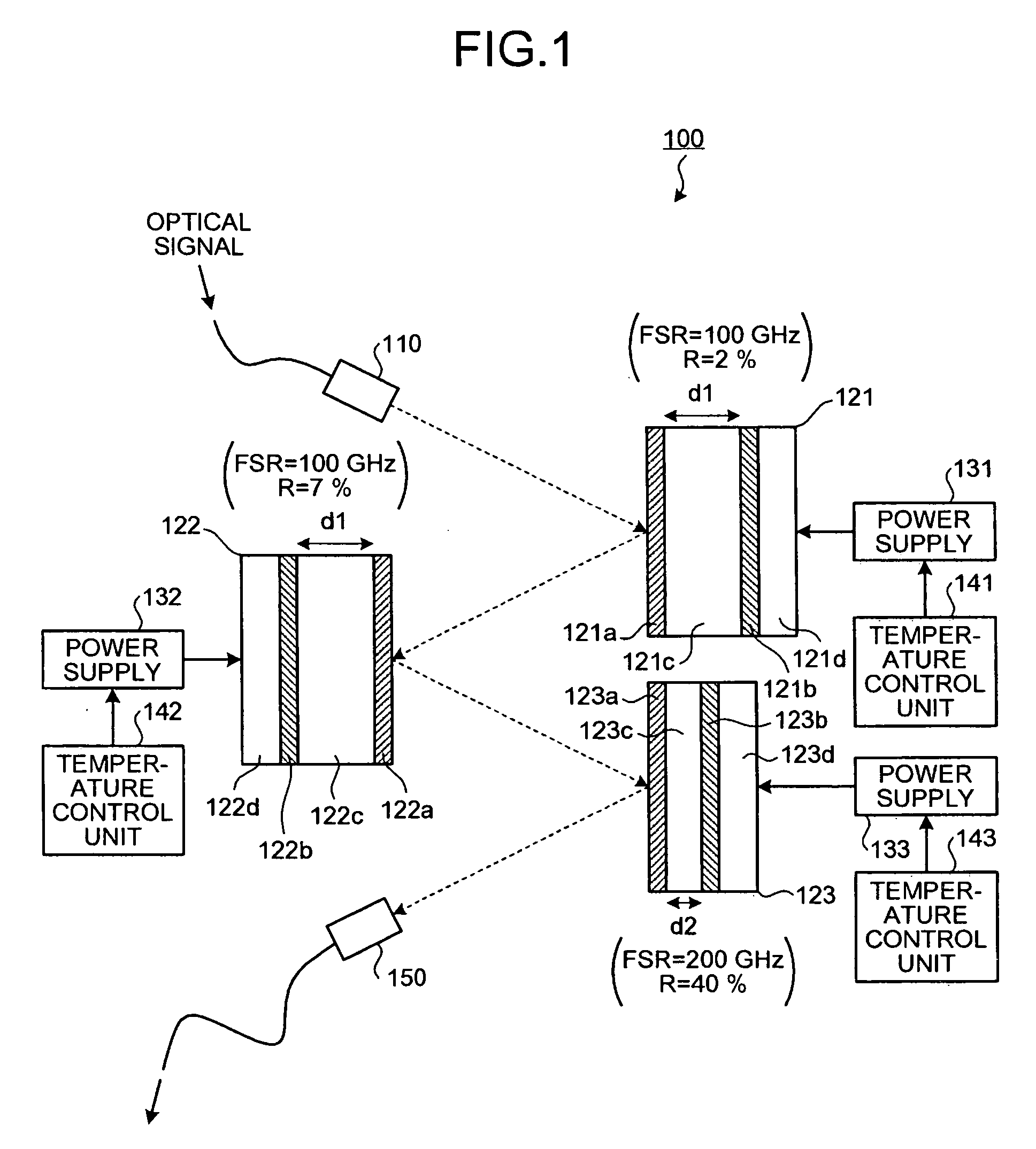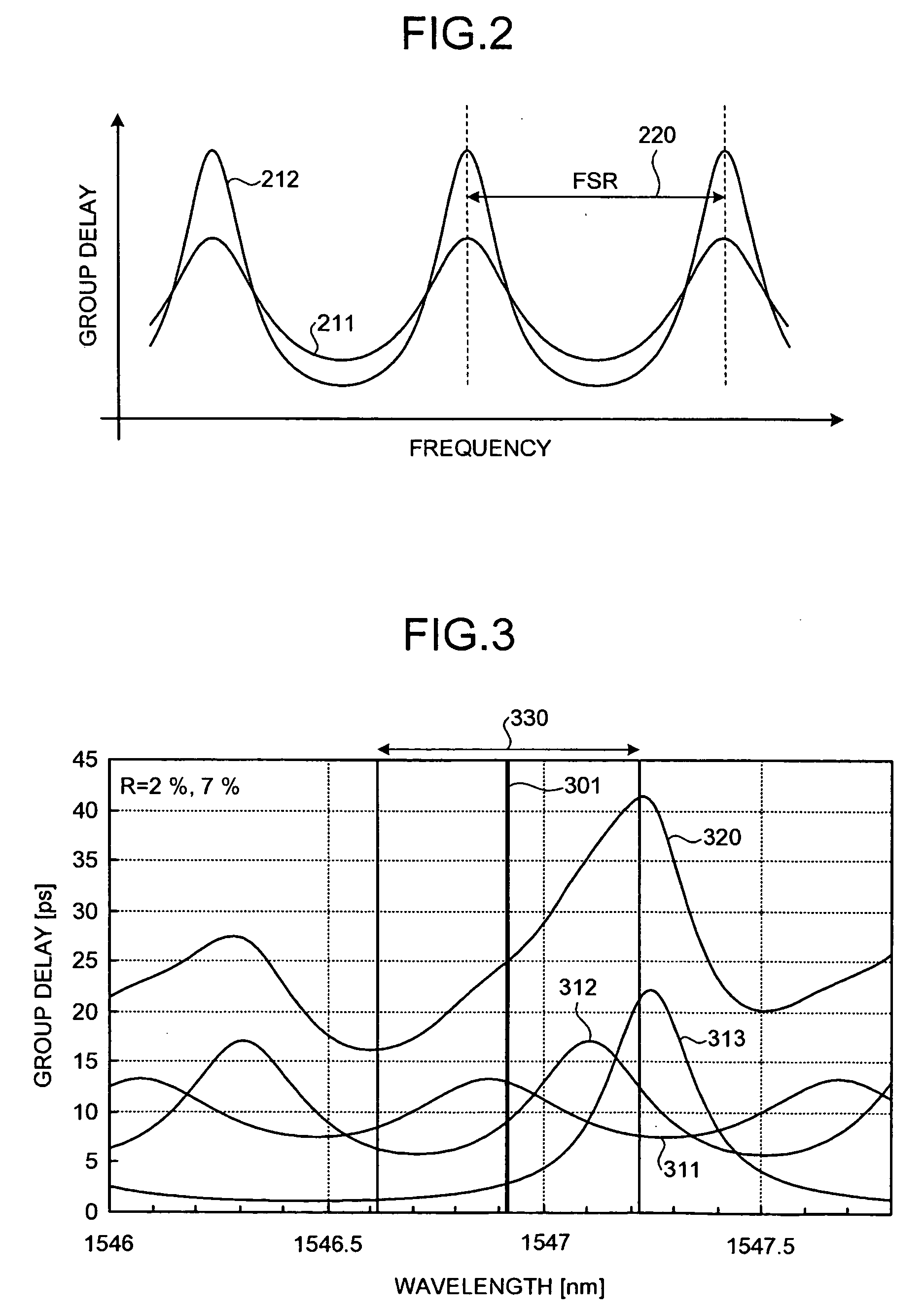Dispersion compensating apparatus
a compensating apparatus and dispersion technology, applied in the direction of instruments, optical elements, optics, etc., can solve the problems of wavelength dispersion, increase the transmission speed of optical signals, and increase the degradation of optical signal pulse waveforms
- Summary
- Abstract
- Description
- Claims
- Application Information
AI Technical Summary
Benefits of technology
Problems solved by technology
Method used
Image
Examples
first embodiment
[0054]As shown in FIG. 1, a dispersion compensating apparatus 100 includes a collimator 110, etalons 121 to 123, power supplies 131 to 133, temperature control units 141 to 143, and a collimator 150. The collimator 110 collimates an optical signal input from an external source and transmits the optical signal to the etalon 121. The etalons 121 to 123 are reflection-type etalons that each impart a group delay for the optical signal that each etalon reflects, respectively.
[0055]The etalon 121 includes a partially reflective film 121a, a totally reflective film 121b, a resonating cavity 121c, and a Peltier element 121d. The partially reflective film 121a partially reflects at a predetermined reflectance R the optical signal transmitted from the collimator 110. An optical signal component not reflected by the partially reflective film 121a passes through the partially reflective film 121a. The totally reflective film 121b totally reflects the optical signal component that passes throug...
second embodiment
[0104]FIG. 8 is a graph indicating the group delay characteristics for each etalon according to the As shown in FIG. 8, components identical to those shown in FIG. 3 are given identical reference numerals and description thereof is omitted. As depicted in FIG. 8, the band 330 is approximately ±0.15 nm (approximately 1,546.8 to 1,547.1 nm). Therefore, the band 330 of the dispersion compensating apparatus 100 is approximately 35 GHz.
[0105]The combined group delay curve 320 represents the combined group delay characteristic having the maximum slope (magnitude of dispersion compensation) in the positive direction when the group delay curves 311 to 313 are appropriately shifted in terms of wavelength respectively using the temperature control units 141 to 143. The magnitude of dispersion compensation for the combined group delay curve 320 is 120 ps / nm.
[0106]The magnitude of dispersion compensation for the combined group delay curve 320 can be varied to −120 ps / nm by shifting in terms of...
third embodiment
[0114]As described above, the dispersion compensating apparatus 900 realizes the effect of the dispersion compensating apparatus 100 and, by combining the etalons 121 to 123 each respectively incorporated in a module, the combination of the etalons respectively having different FSRs and finesses can be easily changed. Therefore, the band and the magnitude of dispersion compensation can be easily adjusted corresponding to the characteristics of the optical signal.
[0115]In the module 910, by reflecting the optical signal plural times between the totally reflective mirror 912 and the etalon 121, the dispersion compensation can be adapted to be multi-staged in the one module. The same is true for the modules 920 and 930. Therefore, the magnitude of dispersion compensation can be increased while facilitating downsizing of the apparatus by reducing the number of etalons.
[0116]Description has been given for a case where the optical signal is reflected plural times by providing a totally r...
PUM
 Login to View More
Login to View More Abstract
Description
Claims
Application Information
 Login to View More
Login to View More - R&D
- Intellectual Property
- Life Sciences
- Materials
- Tech Scout
- Unparalleled Data Quality
- Higher Quality Content
- 60% Fewer Hallucinations
Browse by: Latest US Patents, China's latest patents, Technical Efficacy Thesaurus, Application Domain, Technology Topic, Popular Technical Reports.
© 2025 PatSnap. All rights reserved.Legal|Privacy policy|Modern Slavery Act Transparency Statement|Sitemap|About US| Contact US: help@patsnap.com



